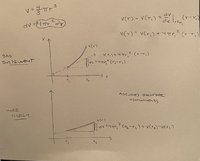mikegonz00
New member
- Joined
- Mar 20, 2021
- Messages
- 11
Hello there,
I'm reviewing differentials from calculus, and I'm a bit confused about how we can interpret them as measurement errors.
For example, the volume of a sphere is given by V=4/3πr3. The differential form: dV=4πr2dr. Let dr=r2-r1. On a graph of V with respect to r, dV is the (vertical) length corresponding to the difference y(r2)-y(r1), where y is the linear approximation at r1. I'm just confused about how that relates to the measurement error
I'm reviewing differentials from calculus, and I'm a bit confused about how we can interpret them as measurement errors.
For example, the volume of a sphere is given by V=4/3πr3. The differential form: dV=4πr2dr. Let dr=r2-r1. On a graph of V with respect to r, dV is the (vertical) length corresponding to the difference y(r2)-y(r1), where y is the linear approximation at r1. I'm just confused about how that relates to the measurement error

